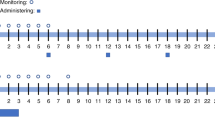Abstract
Pharmacokinetic studies of high-dose treosulfan were carried out in seven paediatric patients (age range: 2–15 years) undergoing treosulfan-based conditioning regimen prior to allogeneic haematopoietic SCT. Treosulfan was administered intravenously in a daily dose of 10, 12 or 14 g/m2 within 2 h. Five out of seven patients received 12 g/m2. The plasma concentrations of treosulfan and its quantity eliminated with urine were determined using a validated HPLC method with refractometric detection. Pharmacokinetic parameters were evaluated following first dose using a two-compartment disposition model. These studies demonstrated a dose-dependent increase of area under the concentration (AUC) and maximum concentrationplasma (Cmax), but there was variability of these parameters. Rapid clearance of tresoulfan was observed, especially in 10 and 12 g/m2 doses. Terminal half-life (t0.5) of treosulfan was in the range of 1.71–2.15 h, but the mean percent of parent drug eliminated with urine was 30%, range 16.3–45.4% of the total dose eliminated during the first 12 h after administration. The results of this study confirmed the linear pharmacokinetics of treosulfan, as used in children. However, variability of pharmacokinetic results observed in children studied demonstrates the need for pharmacokinetic evaluation in each paediatric patient undergoing the treosulfan-based preparative regimen, including those using different doses. This approach could enable further reduction of the risk of early and late organ toxicity related to high-dose treosulfan in paediatric patients.
This is a preview of subscription content, access via your institution
Access options
Subscribe to this journal
Receive 12 print issues and online access
$259.00 per year
only $21.58 per issue
Buy this article
- Purchase on Springer Link
- Instant access to full article PDF
Prices may be subject to local taxes which are calculated during checkout


Similar content being viewed by others
References
Hartley JA, O’Hare CC, Baumgart J . DNA alkylation and interstrand cross-linking by treosulfan. Br J Cancer 1999; 79: 264–266.
Boobis A, Rawlins M, Thomas S, Wilkins M . Treosulfan. In: Dollery C (ed). The Drugs. Churchill Livingstone: Edinburgh, 1999, pp 161–163.
Hilger RA, Harstrick A, Eberhardt W, Oberhoff C, Skorzec M, Baumgart J et al. Clinical pharmacokinetics of intravenous treosulfan in patients with advanced solid tumors. Cancer Chemother Pharmacol 1998; 42: 99–104.
Hilger RA, Jacek G, Oberhoff C, Kredtke S, Baumgart J, Seeber S et al. Investigation of bioavailability and pharmacokinetics of treosulfan capsules in patients with relapsed ovarian cancer. Cancer Chemother Pharmacol 2000; 45: 483–488.
Hilger RA, Baumgart J, Scheulen ME, Trenschel R, Strumberg D, Seeber S et al. Pharmacokinetics of treosulfan in a myeloablative combination with cyclophosphamide prior to allogeneic hematopoietic cell transplantation. Intern J Clin Pharmacol Ther 2004; 42: 654–655.
Werner S, Mendoza A, Hilger RA, Erlacher M, Reichardt W, Lissat A et al. Preclinical studies of treosulfan demonstrate potent activity in Ewing's sarcoma. Cancer Chemother Pharmacol 2008; 62: 19–31.
Beelen DW, Trenschel R, Casper J, Freund M, Hilger RA, Scheulen ME et al. Dose-escalated treosulphan in combination with cyclophosphamide as a new preparative regimen for allogenic stem cell transplantation in patients with an increased risk for regimen-related complications. Bone Marrow Transplant 2005; 35: 233–241.
Scheulen ME, Hilger RA, Oberhoff C, Casper J, Freund M, Josten KM et al. Clinical phase I dose escalation and pharmacokinetic study of high-dose chemotherapy with treosulfan and autologous peripheral blood stem cell transplantation in patients with advanced malignancies. Clin Cancer Res 2000; 6: 4209–4216.
Markiewicz M, Wojciechowska M, Wyleżoł I, Woźniczka K, Giebel S, Wojnar J et al. Unrelated bone marrow transplantation with treosulfan-based myeloablative conditioning for paroxysmal nocturnal hemoglobinuria—successful treatment despite multiple transplant related risk factors for hemolysis including major Kidd group incompatibility. Bone Marrow Transplant 2006; 37: 231–232.
Wachowiak J, Chybicka A, Kowalczyk J, Boruczkowski D, Górczyńska A, Wójcik B et al. Retrospective study on treosulfan-based preparative regimen for allogenic HSCT in children with hematological malignancies and high risk of conventional regimen related toxicity. Bone Marrow Transplant 2005; 35 (S2): 261.
Główka FK, Karaźniewicz-Łada M, Grund G, Wachowiak J . Determination of treosulfan in plasma and urine by HPLC with refractometric detection; pharmacokinetic studies in children undergoing myeloablative treatment prior to haematopoietic stem cell transplantation. J Chromatogr B 2007; 850: 569–574.
Acknowledgements
We thank Medac GmbH from Hamburg for the kind supply of the refractometric detector.
Author information
Authors and Affiliations
Corresponding author
Rights and permissions
About this article
Cite this article
Główka, F., Karaźniewicz-łada, M., Grund, G. et al. Pharmacokinetics of high-dose i.v. treosulfan in children undergoing treosulfan-based preparative regimen for allogeneic haematopoietic SCT. Bone Marrow Transplant 42 (Suppl 2), S67–S70 (2008). https://doi.org/10.1038/bmt.2008.287
Published:
Issue Date:
DOI: https://doi.org/10.1038/bmt.2008.287



